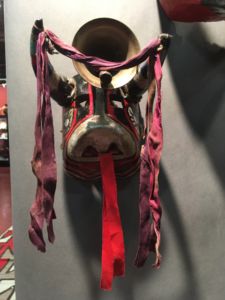The 34th Annual American Indian Art Show was held on Feb. 17 and 18 at the Marin Center in San Rafael, California. The show’s exhibitors boasted a plethora of impressive native art collections from cultures across the Americas. This year’s showcase included the art collections and creations of over 100 artists, dealers and collectors from the Americas. Although the show’s primary focus centered around antique American Indian artwork, there was a strong presence of the contemporary American Indian art style as well. The diverse display allowed attendees to fully immerse themselves in the rich cultural values of the American natives.
Each collection emphasized the regional art tendencies of different tribal communities which were represented by their respective cultural values, beliefs and available resources. This was very evident in the silversmithing of the Navajo people. According to exhibitor Jeffrey Wigginton, the Navajo people of the southwestern states of North America learned silversmithing from early Spanish colonizers. The Navajo incorporated mined turquoise deposits into their jewelry as a symbol of wealth or power in native communities. The inclusion of the intricate jewelry effectively demonstrated how advanced early American Indian civilizations were.
Numerous collectors at the showcase displayed a multitude of native basket styles. Basketry was an important aspect of the show, because this craft represented the heart of California’s American Indian craftsmanship. Many exhibits displayed baskets from members of local Bay Area tribes, especially the Pomo people, who settled throughout the Sonoma, Mendocino and Lake Counties. According to the show’s founder, Kim Martindale, California’s American Indian basket weavers were generally the most skilled at this craft across the Americas, and the Pomo people produced some of the finest baskets. All Pomo baskets were weaved using the coil technique and they were one of the few native groups who often adorned their baskets with materials like clamshells, beads and feathers.
The detailed craftsmanship was essential in demonstrating the originality and cultural tendencies of native groups from different regions of the Americas as they worked with their local natural resources. Showcasing this aspect of native art demonstrated the immense care and effort the natives devoted to their crafts. Including basketry in the art show was fitting, considering the local significance it had in the Bay Area and greater California, as well as its impact on daily life and communal celebrations for many native groups around the Americas.
The American Indian Art Show showcased the cultures of native people farther from the mainland of North America. The most eye-catching collection in the event was Martindale’s wall of Guatemalan

masks. Very specific details on each respective mask were indicative of certain native village communities of this Central American country. The most notable mask was from the village community of Nahualá, which featured a bull face with a bell on its forehead. The integration of the bell with the eye-catching bull carving was indicative of this village and was used in communal dances and gatherings. The inclusion of this exhibit was essential to garnering a deeper understanding of indigenous American cultures beyond the mainland communities of North America.
Another exhibit by Todos Santos Trading Post’s owner Donald Phelps displayed the culture and crafts of Alaska’s Inuit population. Inuit art creations were typically made from whale bone, walrus tusk ivory and stone due to a lack of trees and other vegetation near the Arctic Circle. Their culture was centered around storytelling, where respect for the spiritual interconnections between animals and humans who are intertwined through the Great Spirit of life was spread.
A standout carving from this exhibit was the “Creation Story” sculpture made of walrus ivory tusk. This sculpture represented the Inuit’s story of creation and how all living organisms originate from the Great Spirit. Viewing artistic creations from members of the Inuit clans was essential to understanding their spiritual beliefs and communal values as well as the impact these ideologies had on their daily lives. The exhibit was also another important representation of how native peoples worked with their surrounding natural resources to create their own cultural identity.
Although the 34th Annual American Indian Art Show was primarily run by exhibits with antique art, John Balloue’s contemporary painting style brought his connections with his Cherokee roots to life in the present day. The bright contemporary colors, mixed with meaningful nature symbols of the Cherokee Wolf Clan, fostered this connection. Balloue’s elegant depiction of the Cherokee Wolf represented his connection with his own roots while bringing a new style of modernism with the painting’s brighter colors.
Balloue’s art thoroughly contributed to the main point of the event. Like other exhibitors at the art show, Balloue used his painting skills as a channel to connect with his culture. At the art show, these exhibitors shared their knowledge through their artwork and collections to educate attendees about the sophisticated traditions of native American communities.
Attending the 34th Annual American Indian Art Show demonstrated the foundation of today’s cultural foundations before European expansionism. This experience is an impactful reminder of the significance Native Americans played in the cultivation of society today. The show successfully provided attendees with connections to the native history of the Bay Area and the people that inhabited it through the naturalistic artifacts of indigenous American Indian groups.





